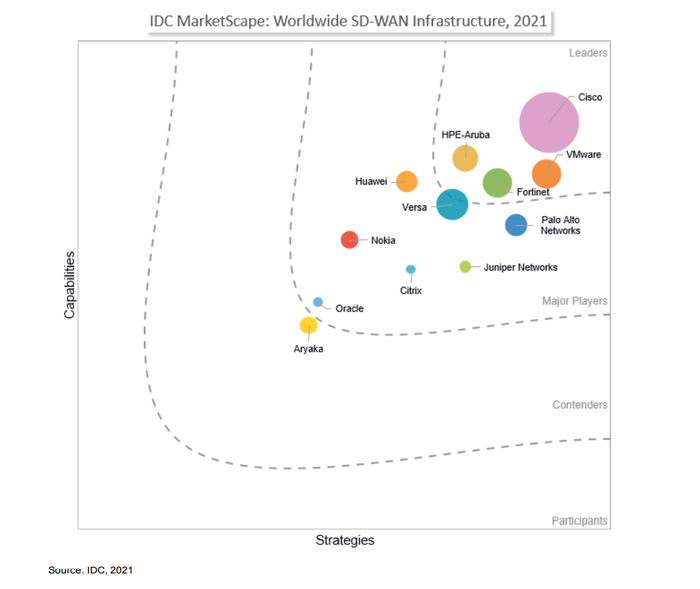New SD-WAN Leaderboard: Cisco, Fortinet, HPE, VMware
Customers are more and more often turning away from box-based SD-WAN.

Cisco, Fortinet, HPE Aruba and VMware are leading their peers in the latest SD-WAN infrastructure rankings.
IDC unveiled its Worldwide SD-WAN Infrastructure 2021 Vendor Assessment, which analyzes 12 vendors and shares trends from the industry. The report showed that the SD-WAN infrastructure market grew 18.5% in 2020 and should sport a CAGR of 18.9% through 2025.
The four vendors listed above all landed in the “Leaders” category. Cisco bested its peers with the best combination of capabilities and strategies. IDC credited Cisco’s go-to-market strategy that features VARs and MSPs, as well as its 2020 acquisition of network intelligence provider ThousandEyes. It’s worth noting that IDC factored the ISR router customer base into Cisco’s SD-WAN market share.

Source: IDC MarketScape: Worldwide SD-WAN Infrastructure 2021
Vendor Assessment
Versa Networks loomed just on the edge of the “Major Players” category. Palo Alto (CloudGenix), Huawei, Nokia, Juniper Networks, Citrix and Oracle also landed among the major players. Aryaka, which has sought to rebrand itself away from a pure-play SD-WAN brand to be known as more of a cloud-based WAN services provider, landed in the “Contenders” category.
IDC made mention of Extreme Networks, which did not fit the criteria but soon will thanks to its recent acquisition of Infovista’s SD-WAN unit. To qualify, vendors needed to have made an SD-WAN infrastructure offering available for the last two years and driven more than $20 million per year in SD-WAN infrastructure.
Trends
IDC noted how demand has risen around “cloud-centric, consumption-based, and highly automated cloud and data center digital infrastructure architecture.” The research firm argued that the adoption of subscription-based SD-WAN offerings to increase faster than “traditional capex-centric infrastructure.” That’s news the agent side of the channel loves to hear, though they likely won’t be surprised.
Take Kyle Hall, president of New York-based Resourcive, for example.
“From my perspective, I’m seeing a lot fewer clients choose to buy and deploy a box. They seem really interested in procuring it as a service,” Hall told Channel Futures this fall. “Maybe the financial model is an upfront versus a recurring, but getting it as a service and having that overlay of management.”
IDC also noted that customers have made always-on connectivity a business requirement. SD-WAN’s ability to provide automated failover helps meet that demand.
Check out the WAN Edge Magic Quadrant Gartner launched recently.
About the Author(s)
You May Also Like


